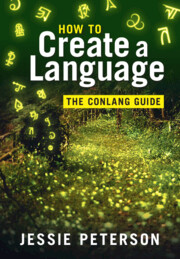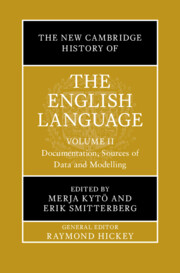Refine search
Actions for selected content:
58 results
How does one’s first language writing script modulate second language reading: evidence from the English Reading Online Project (ENRO)
-
- Journal:
- Applied Psycholinguistics / Volume 46 / 2025
- Published online by Cambridge University Press:
- 19 November 2025, e40
-
- Article
-
- You have access
- Open access
- HTML
- Export citation
Chapter 15 - Orthographic Arguments
- from Part III - New Genres
-
-
- Book:
- African Literature in Transition
- Published online:
- 23 October 2025
- Print publication:
- 06 November 2025, pp 294-312
-
- Chapter
- Export citation

How to Create a Language
- The Conlang Guide
-
- Published online:
- 23 October 2025
- Print publication:
- 02 October 2025
-
- Textbook
- Export citation

The New Cambridge History of the English Language
- Documentation, Sources of Data and Modelling
-
- Published online:
- 18 October 2025
- Print publication:
- 16 October 2025
7 - The History of Books and Printing
- from Part I - The Textual Record
-
-
- Book:
- The New Cambridge History of the English Language
- Published online:
- 18 October 2025
- Print publication:
- 16 October 2025, pp 177-199
-
- Chapter
- Export citation
4 - The Story of English Orthography and Its Analysis
- from Part I - The Textual Record
-
-
- Book:
- The New Cambridge History of the English Language
- Published online:
- 18 October 2025
- Print publication:
- 16 October 2025, pp 101-126
-
- Chapter
- Export citation
16 - Orthography
- from Part III - Expanding Features
-
- Book:
- How to Create a Language
- Published online:
- 23 October 2025
- Print publication:
- 02 October 2025, pp 359-379
-
- Chapter
- Export citation
15 - Reflections on the Interface between Word-Formation and Phonology
- from Part IV - Interfaces
-
- Book:
- Reflections on English Word-Formation
- Published online:
- 03 October 2025
- Print publication:
- 07 August 2025, pp 119-130
-
- Chapter
- Export citation
1 - The Balkan Peninsula and Its Languages
-
- Book:
- The Balkan Languages
- Published online:
- 31 May 2025
- Print publication:
- 26 June 2025, pp 11-64
-
- Chapter
-
- You have access
- Open access
- HTML
- Export citation
Direction of reading, not writing, shapes concepts of time
-
- Journal:
- Language and Cognition / Volume 17 / 2025
- Published online by Cambridge University Press:
- 02 June 2025, e49
-
- Article
-
- You have access
- Open access
- HTML
- Export citation
Tuning in to the prosody of a novel language is easier without orthography
-
- Journal:
- Bilingualism: Language and Cognition / Volume 28 / Issue 5 / November 2025
- Published online by Cambridge University Press:
- 04 February 2025, pp. 1239-1248
-
- Article
-
- You have access
- Open access
- HTML
- Export citation
31 - Orthographic Effects in the Phonetics and Phonology of Second Language Learners and Users
- from Part VI - Variables and Outcomes of Bilingual Speech
-
-
- Book:
- The Cambridge Handbook of Bilingual Phonetics and Phonology
- Published online:
- 14 November 2024
- Print publication:
- 21 November 2024, pp 699-720
-
- Chapter
- Export citation
8 - The Second Language Linguistic Perception Model
- from Part II - Theoretical Models of Bilingual Phonetics and Phonology
-
-
- Book:
- The Cambridge Handbook of Bilingual Phonetics and Phonology
- Published online:
- 14 November 2024
- Print publication:
- 21 November 2024, pp 173-195
-
- Chapter
- Export citation
1 - Introduction
-
- Book:
- The Archaeology of Southern Africa
- Published online:
- 15 May 2024
- Print publication:
- 06 June 2024, pp 1-10
-
- Chapter
- Export citation
33 - Orthographies
- from Part 5 - Sociolinguistic and Geographical Approaches
-
-
- Book:
- The Cambridge Handbook of Slavic Linguistics
- Published online:
- 16 May 2024
- Print publication:
- 23 May 2024, pp 697-714
-
- Chapter
- Export citation
11 - Language and Literacy
-
- Book:
- Fundamentals of Developmental Cognitive Neuroscience
- Published online:
- 11 January 2024
- Print publication:
- 01 February 2024, pp 349-378
-
- Chapter
- Export citation
Chapter 7 - Assyrian Names
- from Part II - Non-Babylonian Names
-
-
- Book:
- Personal Names in Cuneiform Texts from Babylonia (c. 750–100 BCE)
- Published online:
- 02 January 2024
- Print publication:
- 18 January 2024, pp 109-120
-
- Chapter
-
- You have access
- Open access
- HTML
- Export citation
10 - It’s much harder to learn (and teach) my language compared to other languages, and it takes much longer. How can I compensate for these difficulties with my learners?
- from Part II - Differentiation
-
- Book:
- The Art and Science of Language Teaching
- Published online:
- 21 December 2023
- Print publication:
- 21 December 2023, pp 136-150
-
- Chapter
- Export citation
A NEW ACROSTIC AND TELESTIC AT LAVS PISONIS 227–30?
-
- Journal:
- The Classical Quarterly / Volume 73 / Issue 2 / December 2023
- Published online by Cambridge University Press:
- 09 January 2024, pp. 949-952
- Print publication:
- December 2023
-
- Article
-
- You have access
- Open access
- HTML
- Export citation
A lady of leadership: 3D-scanning of runestones in search of Queen Thyra and the Jelling Dynasty
- Part of
-
- Article
-
- You have access
- Open access
- HTML
- Export citation
